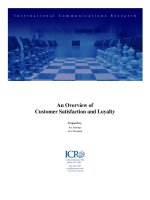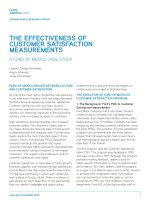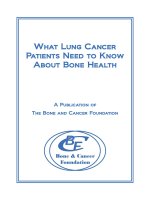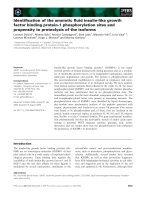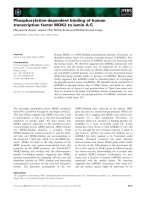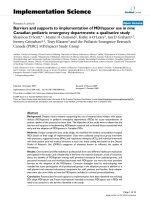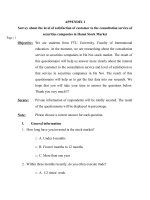Researching about factor effect to satisfaction of customer when use service at thegioididong branch
Bạn đang xem bản rút gọn của tài liệu. Xem và tải ngay bản đầy đủ của tài liệu tại đây (593.4 KB, 45 trang )
RESEARCH PROJECT
(BMBR5103)
RESEARCHING ABOUT FACTOR EFFECT TO
SATISFACTION OF CUSTOMER WHEN USE SERVICE AT
THEGIOIDIDONG BRANCH
STUDENT’S FULL NAME
: HUYNH NGOC TUAN CUONG
STUDENT ID
: CGS00064967
INTAKE
: August 2017
ADVISOR’S NAME & TITLE
: Dr.BUI PHI HUNG
August 2017
Advisor’s assessment
....................................................................................................................................................................
....................................................................................................................................................................
....................................................................................................................................................................
....................................................................................................................................................................
....................................................................................................................................................................
....................................................................................................................................................................
....................................................................................................................................................................
....................................................................................................................................................................
....................................................................................................................................................................
....................................................................................................................................................................
....................................................................................................................................................................
....................................................................................................................................................................
....................................................................................................................................................................
....................................................................................................................................................................
....................................................................................................................................................................
....................................................................................................................................................................
....................................................................................................................................................................
....................................................................................................................................................................
....................................................................................................................................................................
....................................................................................................................................................................
....................................................................................................................................................................
Abstract :
The stiff competition of the retail market, especially the fast-growing smartphone market, are an
opportunity for enterprises can increase their competitiveness, expand markets, especially for a
big brand and perennial as Thegioididong. However that requires business itself must constantly
improve its service quality to entice current customers by smartphone market are showing signs
of saturation. This research paper was using Servqual model consists of five factors that
influence customer satisfaction, along with that is through surveys, collect and analyze data with
Spss to clarify the factors would really strong influence to the customer when using the services
in the branch of 200 D2 , Binh Thanh district of Thegioididong. And technical infrastructure,
varied payment methods, capable of serving staff are factors.
3|Page
Chart list :
Figure 1.1 Conceptual framework ................................................................................................ 17
Figure1.2 Sex and age structure in survey ................................................................................... 23
List of tables :
Table 1.1 Questionnair ................................................................................................................. 25
Table 1.2 The FHY after analysis SPSS........................................................................................ 28
Table 1.3 The RES after analysis SPSS ........................................................................................ 29
Table 1.4 The REL after analysis SPSS ........................................................................................ 30
Table 1.5 The CAP after analysis SPSS........................................................................................ 31
Table 1.6 The EMP after analysis SPSS ....................................................................................... 32
Table 1.7 The SAT after analysis SPSS......................................................................................... 33
Table 1.8 KMO.............................................................................................................................. 34
Table 1.9 Total Variance Explained ............................................................................................. 35
Table 1.10 Rotated Component Matrix......................................................................................... 36
Table 1.11 Model Summary ......................................................................................................... 37
Table 1.12 ANOVA........................................................................................................................ 37
Table 1.13 Coefficients ................................................................................................................. 38
Contents
Executive Summary....................................................................................................................................... 7
Chapter 1 Introduction: ............................................................................................................................. 8
1.1
Research aim : ............................................................................................................................. 8
1.2
Research Question : .................................................................................................................... 8
1.3
Context and relevance : .............................................................................................................. 8
1.4
Scope of research: ....................................................................................................................... 9
1.5
Structure of the Paper : ............................................................................................................ 10
1.6
Conclusion : ............................................................................................................................... 10
Chapter 2 - Literature Review ..................................................................................................................... 11
2.1 Opportunities and challenges in the development of thegioididong intelligent mobile phone
market: ................................................................................................................................................... 11
2.2 The relationship between customer satisfaction and quality service: ...................................... 12
2.3 SERVQUAL model :..................................................................................................................... 14
2.4 Conclusion : ..................................................................................................................................... 16
2.5 Conceptual framwork : .................................................................................................................. 17
Chapter 3 Methodology ........................................................................................................................... 18
3.1 Inductive Approach : ...................................................................................................................... 18
3.2 Quantitative data : .......................................................................................................................... 18
3.3 Research Design : ............................................................................................................................ 19
3.4 Data Collection : .............................................................................................................................. 20
3.5 Data Analysis ................................................................................................................................... 21
3.6 Validity : .......................................................................................................................................... 21
3.7 Reliability : ...................................................................................................................................... 22
3.8 Conclusion : ..................................................................................................................................... 22
Chapter 4 Finding ..................................................................................................................................... 23
4.1 Questionnaires: ............................................................................................................................... 24
4.2 Naming and interpreting the meaning of the factors: ................................................................. 26
4.3 Cronbach's Alpha ........................................................................................................................... 27
4.4 EFA Analysis : ................................................................................................................................. 34
4.5 Regression analysis : ....................................................................................................................... 37
4.6 Conclution : ..................................................................................................................................... 39
Chapter 5 Recomment and conclution .................................................................................................... 40
5|Page
5.1 Overview of Findings :.................................................................................................................... 40
5.2 About Physical foundations : ......................................................................................................... 40
5.3 About Service capabilities : ............................................................................................................ 41
5.4 Limitation of research : .................................................................................................................. 42
5.5 Future of research : ........................................................................................................................ 43
5.6 Conclution : ..................................................................................................................................... 43
Reference : .................................................................................................................................................. 44
Executive Summary
Research paper aims to answer the question: "What factors would affect the satisfaction of
customers using the service in the branch Thegioididong 200, D2, Binh Thanh district, HO CHI
MINH CITY. The content of the research paper clarifying the factors that would affect the
satisfaction of customers using the service in thegioididong, from which identify the factors that
would influence the most to customers, can see the needs of the client, proceed to change the
quality of service for at the same time determine the need to fix weaknesses as well as strengths
need to promote.
Research articles have used quantitative methods to collect data. A table with the number 19
question to conduct the survey of 200 people who have used the service in the branch, 200
Thegioididong D2 Street, Binh Thanh district, HO CHI MINH CITY. The questions focus on the
customers ' opinions about the quality of service at Thegioididong and questionnaire was
distributed to the participants in the next line. Survey results collected will be analyzed through
SPSS software, research shows the full facilities, clean, diverse forms of payment, the interest of
employees to the customer and the employee's understanding of the product need advice
affecting customer satisfaction when using services at Thegioididong.
7|Page
Chapter 1 – Introduction:
1.1
Research aim :
The purpose of this research study is to find out the factors that may affect customer
satisfaction when shopping mobile devices in 200 D2, Binh Thanh district, HO CHI
MINH CITY. Ho Chi Minh. Learn the importance of each factor for business. From that
give the greatest impact factor to the satisfaction of the client, at the same time learn the
requirements of the consumers with regard to product quality, as well as finding ways to
improve the quality of the existing services of the company. Moreover this study to
review the advantages and disadvantages in comparison with competitors in the same
industry.
1.2
Research Question :
“What factors affect customer satisfaction when using the service at the branch
thegioididong, 200 D2 Street, Binh Thanh District, Ho Chi Minh City? "
1.3
Context and relevance :
Smartphone has become an indispensable means for the life of the people, by the
convenience as well as the efficiency in life and daily work that it brings. According to a
study that showed the students can check their smartphone 60 times in a day and can
continuously use them more than 4 hours a day (Harman & Sato, 2011; Kang Jung & the
year 2014; Lepp, Barkley, & Karpinski, 2014), the web Page "We are social" has taken
the statistics about the trend to use the internet, remote network and especially mobile of
the 30 countries in the world including Vietnam. Vietnam's population is specifically
more than 90 million people will come to 39.8 million internet users (44%), 28 million
people own social networking accounts (about 31%), 128.3 million people had mobile
networking (141%) and the number of people using social accounts on your phone is 24
million (26%) and according to the report "the situation of mobile ads in regions of Asia,
Thai Pacific Opera "by Mediaworks and Marketing Association made in 2015, Vietnam
is one of four countries in the Asia-Pacific region has a fast growth rate of the number of
smart phone users. Traffic levels are used in Vietnam reached the highest landmark in the
area. For every users in Vietnam using 85MB/month, close by the global average with 90
MB/month.
It shows the level of penetration of smartphone on in life is growing constantly. And that
is a piece of fertile land to businesses trading on the smartphone product in General and
particular Thegioididong can exploit and make profit. And to do that job, then the
customer satisfaction is the essential thing, to be able to change the products, services or
create competitive advantages that the opponent does not have to be aimed at retaining
customers.
1.4
Scope of research:
This essay clarify the factors affecting customer satisfaction when using services at the
branch thegioididong smartphone, 200 D2 Street, Binh Thanh District, Ho Chi Minh
City. Investigate their importance as guest impact resistance in the process of using the
service and what factors are most important in determining the behavior of their
purchases. Finally, to clarify the business opportunities, the strengths and weaknesses that
exist in thegioididong, helping the company can utilize, develop business advantages, as
well as improve weaknesses, increase competitiveness in the smartphone market are too
many competitors today.
However this research paper also inevitable that the points limit. This dissertation
research in a short time, so that the research is also done in a limited range, it is in the
branch, number 200 Thegioididong D2 Street, Binh Thanh district, HO CHI MINH
CITY. , In order to ensure progress. If there is sufficient time, then the research can be
done in the other branch in Phu Nhuan district, District 1, District 3 ... and many other
affiliates also have a very large customer, in order to have a broader results. And
followed the survey questions to be applied on a random sample survey with the
participation of 250 people and the answers of the candidates participate in a survey may
not be accurate.
9|Page
1.5
Structure of the Paper :
The essays are arranged according to the chapter to be able easily to the system.
Introduction : Introduction to the need, as well as the reason to choose this topic. Present
research objectives, scope, object as well as research methods.
Literature review : Giving evidence on the relationship between quality of service and
customer satisfaction. Talking about the Servqual model and the urgency it for this topic.
Methodology : Clarification of the research approach, advantages of quantitative
research, method of collecting and analyzing data obtained by the software spss. At the
same time clarify the credibility of this study and the limited existence of corruption.
Finding : Analysis of results from the survey of generation of revenue through software
spss, clarify the factors would really impact on the satisfaction of customers using the
service in the branch, number 200 Thegioididong D2, Binh Thanh district, Ho Chi Minh
City.
Recomment and conclution : Affirm again the strong impact factor to the satisfaction of
the customer, from there take out the solutions to enhance the quality of service based on
the factors that enhance customer satisfaction.
1.6
Conclusion :
In this chapter, we have seen a general way about the goal as well as the method of
performing the research. In the next chapter will present the scientific research related to:
"the factors affecting the satisfaction of customers using the service in the branch,
number 200 Thegioididong D2 Street, Binh Thanh district, HO CHI MINH CITY. "In
order to collect more information on the issues surrounding.
Chapter 2 - Literature Review
2.1 Opportunities and challenges in the development of
thegioididong intelligent mobile phone market:
In the rapid development of mobile communication, network and Internet service has
become an indispensable part in daily life, (to 2014). Then this is the continuous
development of the intelligent mobile phone, open a new era of technology has become
widespread and gradually replace the notebook computer of such equipment ( Castaldi &
addeo 2007).
The website "We are social" has taken the statistics about the trend to use the internet,
social networks and especially mobile of the 30 countries in the world including
Vietnam. Specifically, Vietnam's population is more than 90 million people will come to
39.8 million internet users (44%), 28 million people own social networking accounts
(about 31%), 128.3 million people had mobile networking (141%) and the number of
people using social accounts on your phone is 24 million (26%). The company also
Appota most put out a few numbers relating to the mobile sector in Vietnam. According
to the report, Vietnam currently has about 22 million people use smartphone. Among the
22 million users, has more than 200 million downloads of applications from both IOS and
Android operating systems. Can see the smartphone are a fertile business market for
Thegioididong, especially in Ho Chi Minh City.
However, according to the report by market research company GFK, in 2013, the total
sales of electronic products-electrical machines in Vietnam totaled about 5.4 billion
dollars, of which, private phone plate up to nearly 2 billion. Thegioididong (TGD )
currently occupy about 25% of the retail market in Vietnam, followed by a number of
names such as Telecommunications, Naidu, FPT, Viettel. As a retail distributor emerging
smartphone, Thegioididong are much more favorable in the competition with the other
big man. So the advanced quality of service, product diversification, enhance the
satisfaction of customers is extremely important.
11 | P a g e
2.2 The relationship between customer satisfaction and quality
service:
According to Wolfgang Kersten and Jan Koch 2010, quality service is the gap between
the expectations of customers with the quality of that service. The service is not material
that is relevant and experience with client satisfaction (according to George c. l. Bezerra,
Carlos f. Gomes 2015) and measure the quality of service and customer satisfaction has
been the business interest. The quality of service as the source of life of a business, the
value of the service provider for clients becomes a competitive advantage (Mohsan
Khudri Saida Sultana 2015). Moreover, the growth of mobile subscribers as well as
popular as smartphone usage today, enhancing the quality of the service again becomes
more important for the mobile world.
There have been many research paper talks about the quality of service and how to
measure it as:
Studies on the effects of service quality dimensions and passenger
characteristics on passenger's overall satisfaction with an airport of George
c. l. Bezerra, Carlos f. Gomes 2015: research aims to study the influence of
the quality of service of the airport to Brazillian satisfaction of customers.
As research by MEHDI ZAIBAF, FARIZ TAHERIKIA, and MEYSAM
FAKHARIAN 2015 about Effect of Perceived Service Quality on Customer
Satisfaction in Hospitality Industry: Gronroos'Service Quality Model
Development: research is focused primarily on the impact of the quality of
service for the feel and research shows the image of the business have a
positive impact on customer satisfaction.
The influence of the quality of New zeland banking services to the
satisfaction of the client by analyzing the data obtained was made by Michel
Rod, Nicholas j. Ashill, Jinyi Shao and Janet Carruthers in the year 2008,
results show a relationship between the quality of information systems,
product quality of banking services internet service, quality and customer
satisfaction.
According to Cristina Calvo-Porral and Jean-Pierre Lévy-Mangin (2016) then the
customer loyalty provides long-term competitive advantage, so that maintaining current
clients is the indispensable job. And to do that, the satisfaction of customers is always the
problem that the trader concerned to minimize the customer decide to choose a product or
service from the competition. Business must focus improving the quality and value of the
service, make the customer clearly benefits and their value to the business. So also with
the Heesup Han and Sean Sunghyup Hyun (2017), one of the tasks for improving the
satisfaction of the customer about the service that the hotel is enhanced tuber quality
service, thereby enhancing overall product sales. From there turn the satisfaction into
loyalty to the business. Increase profits for the company in terms of the long term.
On the other hand for Leila Agha Kasiri, Kenny Teoh Cheng Guan, Murali Sambasivan,
Samsinar Md Sidin (2017)., changing, customizing services contribute to improving the
quality of service, quality has a strong impact on customer satisfaction and ultimately
decided to satisfaction of customer loyalty. Key to the increase of the level of competition
has meant that businesses must change to meet the service needs of customers (according
to Beatty, 2015), by the customer not only interested in the quality of service that it is the
method that they can get the product or service. Not stop there in the Logistic field,
customer satisfaction plays a role of utmost importance in the environment in which the
needs of the customers and they have many more choices about products and
services. Required the company to grasp the needs of the client, create a competitive
advantage, reduce competitors, improve customer satisfaction, which can expand the
business. It is not just the quality of the service, but also the price, how to serve ... (By
Ieva Meidut -Art ras Aranskis, M., Litvinenko Kavaliauskien 2013).
Finally, the quality of the service, satisfaction, customer loyalty and profitability of
business relationships interwoven together (according to Nesrin Ozatac, Tulen Saner,
Zeynep Suzmen Sen 2016). The increase of this element will also positively influence the
rest of the elements. And the satisfaction of customers is one of the important elements to
create success. The development, improve the service helps businesses create s u
differences with opponents.
13 | P a g e
2.3 SERVQUAL model :
Quality evaluation model of services, this model by Parasuraman and proved in 1988. The
system consists of 22 questions with integrity to the 5 components with the reviews of the
quality of customer service. The distribution of the quality of service concepts in the
structure as follows: tangible, credible, feedback, make sure and empathy. It is based on
the distance between the expectations and the customer's experience, which can be
negative or positive if the higher expectation of experience or expectation is less than or
equal to the corresponding experience. (By Parasuraman et al., 1985; Zeithaml et al.,
1990).
According Yousapronpaiboon Khanchitpol 2014:
Reliability Group: measuring the level of implementation of the proposed
service program with 5 variables observed
The level of response: measure the ability to perform timely and on time
service with 3 variables observed
Group capacity: measuring the ability to create trust and peace of mind of
customer services unit with 4 variables observed
The level of empathy: the measurement of the ability of concern, sympathy
and care of each individual customer with 4 variables observed
Tangible physical media Group: measuring the level of attractiveness, of the
physical equipment, hours of service, as well as the costumes of the staff with
the observed variables 5
In the distance the service quality in the SERVQUAL model include: firstly, the gap
appears when there are differences between the customer's expectations of quality service
that administrators feel about the expectations of the customer. This distance expressed in
that the service provider does not know all the trait would make up the quality of its
services as well as the method of delivery to customers to satisfy their needs.-About how
the two, is the difficulty in transforming their perceptions about the expectation of the
client into the quality characteristics of the service. Despite knowing the expectations of
customers as do professional ability of staff, About the third way, appears when employees
do not transfer services to customers according to the specific criteria were originally
Allied Scouts determine. The staff is the important role parts in creating quality of service,
if some employees did not complete the tasks according to the criteria will affect the
quality of the service. The promise from advertising will increase the expectations of
customers, when they are not implemented as what was promised, it will reduce the quality
that customers perceive. This is about the fourth way. And in the end the difference
between the expected quality and quality they felt. This is precisely the distance
Thursday. (By Edward Shiu, Liz Vaughan and Mike Donnelly 1997). This distance
depends on the four previous distance. Parasuraman & ctg (1985) for that quality of service
is dependent on the distance this Thursday, to reduce the gap to reduce the four distance
above. (Parasuraman & ctg, 1988).
The advantage of using Servqual model: (according to the 2002 Blixrud): The service
provider can obtain the weapon forward feedback from customers who are using the
service. With the assistance of the analysis tools we found was exactly the problem that the
customer is experiencing, or customer's needs with respect to how the current service from
the quantitative data that we obtained through surveys or other strong points are the way it
needs to promote and weaknesses need to be overcome. The provider may change or
improve the quality of existing services, thereby enhancing customer satisfaction, enhance
the image of your business, be classified into different segments according to the Servqual
scores. Moreover, Servqual also can apply in many areas of service in various
circumstances such as:
Research of Dr. Gantasala v. Prabhakar in 2013 on SERVQUAL and Customer
Satisfaction: The Mediating influence of Communication in the Privatized
Telecom sector, the study mainly examined the impact of service quality for
customer satisfaction in a telecommunications company in Oman by Servqual
model.
Study of Applicability of SERVQUALin restaurants: an exploratory study in a
Portuguese resort, research to clarify the availability of the Servqual model
with the restaurant service with survey consists of 300 people in a villa in
Portugal.
Research on the Use of Servqual in the Evaluation of Ser vice quality of
Academic Libraries in developing countries by Brendan e. A sogwa BEA 2014
has pointed out the negative in the differences in the use of library services, the
library does not have not met the expectations of the customer. Model Servqual
15 | P a g e
was applied to compare the quality of academic library services between the
developed and the developing.
2.4 Conclusion :
As such, the quality of service has a positive or negative impact on the satisfaction of our
customers, especially during the development of the use of mobile devices such as the
present, with the number of people using mobile devices, stats are significantly increased
by the ITU (international telecommunications organization) , so there is the opportunity to
Thegioididong can enhance the quality of our services to improve client satisfaction,
however Thegioididong faced lie about the market share of the major such as FPT, Naidu,
CellphoneS, Mobilecity ... and raising customer satisfaction important more than ever
through improving competitive advantage and overcoming the limitations that currently
exist in the enterprise. Can be seen with the advantages of the Servqual model, it is used
more in evaluating service quality in many different cases, so can fully apply the model to
apply to services in the branch, number 200 Thegioididong D2 Street, Binh Thanh district,
HO CHI MINH CITY.
2.5 Conceptual framwork :
Tangible infrastructure
Level of trust
The level of response
The
satisfaction
Service capabilities
The level of empathy
Figure 1.1 Conceptual framework
17 | P a g e
Chapter 3 – Methodology
3.1 Inductive Approach :
Research articles using the inductive method (bottom-up approach). In an inductive
approach to research, a researcher begins by collecting data that is relevant to his or her
topic of interest. Once a substantial amount of data have been collected, the researcher will
then take a breather from data collection, stepping back to get a bird's eye view of her
data. At this stage, the researcher looks for patterns in the data, working to develop a
theory that could explain those patterns. Thus when researchers take an inductive
approach, they start with a set of observations and then they move from those particular
experiences to a more general set of propositions about those experiences. In other words,
they move from data to theory, or from the specific to the general. There are many good
examples of inductive research, but we'll look at just a few here. One fascinating recent
study in which the researchers took an inductive approach was Katherine Allen, Christine
Kaestle, and Abbie Goldberg's study (2011) of how boys and young men learn about
menstruation. To understand this process, Allen and her colleagues analyzed the written
narratives of the 23 young men in which the men described how they learned about
menstruation, what they thought of it when they first learned about it, and what they think
of it now. By looking for patterns across all 23 men's narratives, the researchers were able
to develop a general theory of how boys and young men learn about this aspect of girls '
and women's biology. They conclude that the sisters play an important role in boys ' early
understanding of menstruation menstruation, that makes the boys feel somewhat separated
from girls, and that as they enter young adulthood and form romantic relationships, young
men develop more mature attitudes about menstruation.
3.2 Quantitative data :
Quantitative research gathers data in numerical form which can be put into categories, or
in rank order, or measured in units of measurement. This type of data can be used to
construct graphs and tables of raw data. Quantitative researchers aims to establish general
laws of behavior and phenonomon across different contexts. Research is used to test a
theory and ultimately support or reject it (Research methods for business students - Mark
Saunders ,Philip Lewis ,Adrian Thornhill-2009). Quantitative data can be interpreted with
statistical and since statistics are based on the principles of mathematics, the quantitative
approach is viewed as scientifically objective, and rational (Carr, 1994; Denscombe,
2010). Useful for testing and validating already constructed theories. Sophisticated
software removes much of the need for prolonged data analysis, especially with large
volumes of data involved (Antonius, 2003). Quantitative data is based on measured values
and can be checked by others because numerical data is less open to ambiguities of
interpretation. Hypotheses can also be tested because of the used of statistical analysis
(Antonius, 2003). In this chapter, data has been collected through quantitative
questionnaire.
3.3 Research Design :
Quantitative research data can be obtained through the method of:
Interviews
Personal one-on-one interviews may also be used for gathering quantitative
data. In collecting quantitative data, the interview is more structured than
when gathering qualitative data, comprised of a prepared set of standard
questions.
Quantitative Observation
This is straightforward enough. Data may be collected through systematic
observation by, say, counting the number of users present and currently
accessing services in a specific area, or the number of services being used
within a designated vicinity.
When quantitative data is being sought, the approach is naturalistic
observation, which mostly involves using the senses and keen observation
skills to get data about the “what”, and not really about the “why” and “how”.
Experiments
They are considered to be a form of experiment, and are quantitative in
nature. These methods involve manipulation of an independent variable,
while maintaining varying degrees of control over other variables, most likely
19 | P a g e
the dependent ones. Usually, this is employed to obtain data that will be used
later on for analysis of relationships and correlations.
This research paper using questionnaires do design research. Questionnaires can be
classified as both, quantitative and qualitative method depending on the nature of
questions. Specifically, answers obtained through closed-ended questions with multiple
choice answer options are analyzed using quantitative methods and they may involve piecharts, bar-charts and percentages, whereas answers obtained to open-ended
questionnaire questions are analyzed using qualitative methods and they involve
discussions and critical analyses without use of numbers and calculations. Specifically
here is to use scaling Questions. Also referred to as ranking questions, present an option
for respondents to rank the available answers to the questions on the scale of given range
of values (for example with this research is from 1 to 5). With 19 questions related to the
human elements of incense to the satisfaction of customers using the service in the
branch, number 200 Thegioididong D2 Street, Binh Thanh district, HO CHI MINH
CITY.
The questionnaire was designed to standardize, so have the objectivity than gathering data
through interviews. Besides answering the same question survey also increases
fairness. Next, the information collected through the questionnaire can narrow the time
survey and research, as well as save a lot of costs, in accordance with the circumstances of
the time require quite limited of this research paper.
3.4 Data Collection :
The data collection was conducted with 250 random clients used the service to buy the
smartphone as well as repair services in the branch, number 200 Thegioididong D2 Street,
Binh Thanh district, HO CHI MINH CITY. Ho Chi Minh. The survey and information
gathering took place from 20 to 28 July of the year 2017, when in time this branch
Thegioididong are entered on many smartphone items, especially items that are consumers
of qian. Because the issue of time limits should the survey can only be performed in the
branch of 200 D2, Binh Thanh district and at random.
3.5 Data Analysis
To analyze the data collected, the study has used the tool SPSS statistical software, is
commonly used for investigative studies sociology and Econometrics. Descriptive
statistics, testing the reliability of scales with Cronbach's Alpha analysis, correlation,
linear regression, multiple and single-medium (T-test) through SPSS, the data obtained
can be reflected through the tables, Visual chart. SPSS is a popular application in market
research: research and product development, expand the market; the satisfaction of our
customers. As the study of Wang Huanzhang, Kyung Hoon Kim, EunjuKo, Honglei Liu
about the Relationship between service quality and customer equity in traditional markets
2016 has used spss to analyze data and service quality has a significant influence to the
equality of the client on the market system and Emmy which is the most important factor
to increase customer satisfaction. So the use of SPSS workable for this study.
3.6 Validity :
Leydens & Moskal (2002) determined the validity is "the extent to which the evidence
supported the interpretation of the data is accurate and using proper interpretation". In
other words, Joppe (2000) stated that validity is if the result is honest and reliable. He also
adds that in order to determine the validity, researchers often put out a series of questions,
and will often search for answers in the research of others to know whether measurements
are correct or not.
Because of the limited time for research should only be performed in the branch number
200 Thegioididong D2, Binh Thanh Dist. Along with the model number just 150 people
any restriction makes the results of the survey of the factors affecting the satisfaction of
customers could not cover all the customers in all branches of Mobilecity on both the
water. In addition, the individuals who participate in reviews also make the effect of the
reduced, research by the information they provide may not be real or by inertia, also make
the results of research are not correctly.
21 | P a g e
3.7 Reliability :
The restrictions on research time, limited sample sizes as well as restrictions on the survey
area has reduced the credibility of the research. To fix this, the survey conducted in many
places that specifically here is the other branch in Phu Nhuan district, District 1 ... along
with choosing a sample size being bigger than is necessary, to be able to cover all the
clients in the branch of Thegioididong from which enhance the reliability of the research.
3.8 Conclusion :
So this chapter has clarified that the research method was carried out to collect the
required data, along with tools used to analyze and complete lines out survey results, as
well as inductive research approach and details of time, place and performed survey data
analysis in order to answer the question: ": these factors would affect the satisfaction of
customers using the service in the branch, number 200 Thegioididong D2, Binh Thanh
Dist. Additionally, clarify the limitations as well as the reliability of the research paper.
Chapter 4 – Finding
The survey was conducted by distributing a questionnaire to 200 participants to clarify the
research question: "What factors would affect the long of the client when using the
services in the branch, number 200 Thegioididong D2 Street, Binh Thanh district". In
which 97 people (48.5%) is male and 103 female persons (51.5%) occupied. In which 63
survey participants under age 18 (31.5%), 44 of whom are aged from 18-25 (22%), 47
people between the ages of 25-40 (22%), 46 people over 40 years old (23%).
Number of people in survey(%)
Male
Female
Age components participated
in the survey(%)
35
30
25
20
Age components
participated in the
survey(%)
15
10
5
0
<18
18-25
25-40
>40
Figure1.1 Sex and age structure in survey
23 | P a g e
4.1 Questionnaires:
Criteria(Tiêu chí)
Group of physical
foundations(Nhóm
c s v t ch t h u
hình)
Reliability
level(M c đ tin
c y)
The level of
response(M c đ
đáp ng)
Service
capabilities(N ng
l c ph c v )
Question(Câu h i)
1. Facilities of Thegioididong is full,
clean(C s v t c t c a Thegioididong có
đ y đ , s ch s )
Rating score - 1: worst,
5: best( i m đánh giá-1:
kém nh t, 5: t t nh t)
1
2
3
4
5
1
2
3
4
5
1
2
3
4
5
1. The quality of the product is exactly as
advertised(Ch t l ng s n ph m có đúng
nh qu ng cáo)
1
2
3
4
5
2. The company delivery on time(Công ty có
giao hàng đúng h n)
1
2
3
4
5
3. The company made a mistake in the
process of providing services to
customers(Công ty có sai sót trong quá
trình th c hi n d ch v đ i v i khách
hàng)
1
2
3
4
5
1. The company is available to assist you
when your smartphone fails(Công ty có
s n sang h tr cho b n khi smartphone b
l i)
1
2
3
4
5
2. The staff will advise you as soon as the
purchase(Nhân viên có t v n cho b n
ngay khi đ n mua hàng)
1
2
3
4
5
3. Does the company tell you when the
goods are delivered?( Công ty có cho b n
bi t khi nào hàng đ c giao)
1
2
3
4
5
1. Thegioididong employees have shown
interest in customers(Nhân viên
Thegioididong có t ra quan tâm đ n
khách hàng)
1
2
3
4
5
2. Staff are courteous to you(Nhân viên có
l ch s v i b n)
1
2
3
4
5
3. Employees have the right product advice
the customer needs(Nhân viên có t v n
chính xác s n ph m khách hàng c n)
1
2
3
4
5
2. Staff dressed politely (Nhân viên n m c
l ch s )
3. Rich forms of payment(Hình th c thanh
toán đa d ng)
Level of
empathy(M c đ
đ ng c m)
1. Employees recognize and remember your
name(Nhân viên có nh n ra và nh tên
b n)
2. Does the level of service and price of
service meet the requirements of
customers and fit their pocket?( M c đ
ph c v và giá c d ch v có đáp ng
đ c yêu c u c a khách hàng và có v a
v i túi ti n c a h không?)
3. Is Thegioididong flexible enough to meet
customers' plans and programs?(
Thegioididong có đ linh ho t đ đáp ng
k ho ch, ch ng trình c a khách hàng
không?)
1. Your shopping needs at Thegioididong
are met well(Nhu c u mua s m c a anh
(ch ) t i Thegioididong này đ c đáp ng
t t)
2. You see Thegioididong as your first
choice(Anh (ch ) xem Thegioididong là
s l a ch n đ u tiên)
Satisfaction(S hài
lòng)
3. You will continue to purchase goods at
Thegioididong for the next time.
(Anh(ch ) s ti p t c mua hàng t i
Thegioididong cho l n sau)
4. You will introduce to your friends,
acquaintances to Thegioididong(Anh
(ch ) s gi i thi u cho b n bè, ng i quen
đ n Thegioididong)
1
2
3
4
5
1
2
3
4
5
1
2
3
4
5
1
2
3
4
5
1
2
3
4
5
1
2
3
4
5
1
2
3
4
5
Table 1.1 Questionnair
25 | P a g e
